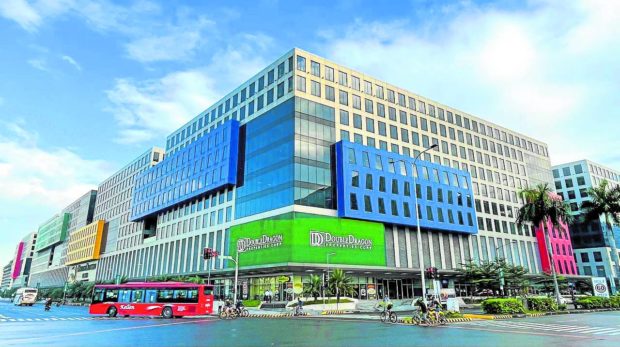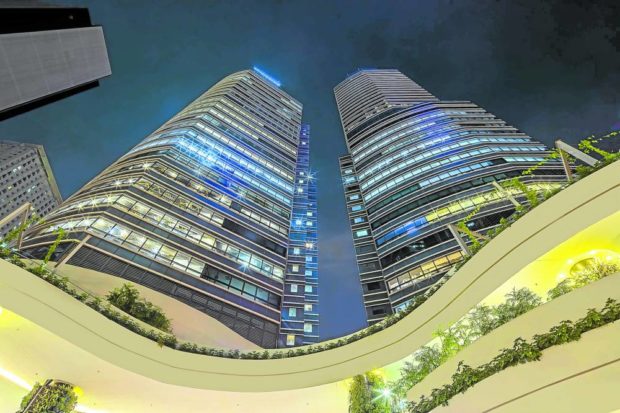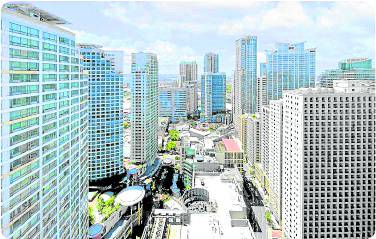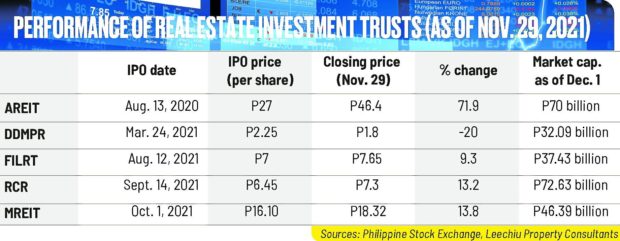REITs: Recycling capital, democratizing property investing
The first time that lawyer “Randy” (not his real name) invested in the stock market in April last year, he used all his investible funds to buy shares of AREIT Inc., the real estate investment trust (REIT) created by property giant Ayala Land Inc.
Shares of AREIT dipped in the first few weeks after its listing on the stock exchange in April 2020. But instead of panicking, Randy scooped up more shares at a lower price. After all, he had ample funds left as his stock broker was not able to give him the full AREIT initial public offering (IPO) allotment that he wanted. With his buying average even lower than IPO price, Randy’s AREIT stocks have since appreciated by 63 percent.
Based on the closing price of P43.65 on Dec. 1, the share price of AREIT appreciated by 61.7 percent from the initial public offering price of P27 per share. It outperformed the Philippine Stock Exchange index (PSEi), which rose by 23.8 percent during the same period.

REITs allow you to invest directly in finished, income-generating products such as offices.
On top of the stock price upswing, Randy got a cash dividend of P1.32 per share from AREIT in 2020 and another P1.30 per share this 2021.
Since AREIT raised the curtain for this new asset class, four more REITs have debuted on the Philippine Stock Exchange, sponsored by some of the country’s largest property developers: DDMP REIT of DoubleDragon Properties; Filinvest REIT Corp. of Filinvest Land; RL Commercial REIT Inc. of Robinsons Land and MREIT Inc. of Megaworld Corp.
Article continues after this advertisementAll five of them successfully tapped the stock market amid a raging pandemic, raising a sum of P78 billion in fresh capital that could be redeployed by the sponsors to new projects as they position themselves for postpandemic long-term growth. This was because all these REITs had portfolios that were focused on the sub-segment of the property industry that was most resilient to the pandemic: office property leasing.
Article continues after this advertisementExcept for DDMP, which was hit by concerns over the exodus of Philippine offshore gaming operators, stocks of all other REITs appreciated since listing on the stock market, drawing strength from the resilience of business process outsourcing (BPO) firms which constitute bulk of their portfolios. (See table on stock performance). These five REITs now have a combined market capitalization of nearly P260 billion.

REITs have collectively done well this year.
New asset class
Over a long-term horizon, real estate trumps all other asset classes, whether they be equities, fixed income securities, cash or commodities. As they say, you can’t go wrong with property investing, and if you get it wrong, time will correct it.
But one big hurdle to building a real estate portfolio is the relatively large investment needed to own a parcel or unit. There’s also lack of liquidity. When you suddenly need cash and want to sell your property, it may be a long wait to find someone willing to buy it at the price you want. Those in a hurry to liquidate will have to accept fire sale pricing.
But what if you have the ability to be part owner of a real estate company that already generates recurring income from a mature portfolio that will yield attractive dividends every year?
This is the essence of REIT. It allows you to invest directly in finished, income-generating products such as office units, hotels, shopping malls, industrial properties, residences for rent, or even infrastructure ventures like toll roads and power plants. The participation rate is relatively affordable. Even if you can’t afford to own that sleek new office building along Ayala Avenue, maybe you can afford to buy some shares of the company that runs it.
This new asset class–at least to the Philippine market–is meant to attract dividend-seeking investors because the Philippine REIT Law of 2009 requires the distribution of at least 90 percent of income annually.
“Aside from the potential advantages this investment instrument provides to investors, REITs provide a positive multiplier effect on the economy due to enhanced economic activity. Furthermore, REITs may help boost government’s build, build, build program given the wide range of real estate property assets it can own, including hospitals, cell towers, airports, seaports, and infrastructure development. The reinvestment clause in the REIT rules of the Securities and Exchange Commission also facilitates that proceeds from identified activities are invested back in real estate or infrastructure projects in the country,” said PSE president Ramon Monzon.

REITs provide a positive multiplier effect on the economy due to enhanced economic activity.
Pandemic-proof
Despite higher than usual office vacancies in 2021 due to the pandemic, REITs have collectively done well, thanks to quality office stocks with high occupancies, said Leechiu Property Consultants (LPC). Its latest research estimates that occupancy rates of all the five REITS average at 90 percent and higher.
“It is to the credit of the REIT sponsors that they put together resilient IT-BPM (information technology-business process management) heavy office portfolios that squarely addressed market jitters,” said Roy Golez, LPC research and consultancy director.
The gross leasable areas (GLAs) of the top portfolios are likewise 100 percent accredited by the Philippine Economic Zone Authority (PEZA). The limited supply of PEZA space up to 2025 also ensures that these portfolios will remain highly viable for the next few years, added Mikko Barranda, LPC director for commercial leasing.
Barranda said that even at the height of the lockdowns in 2020, IT-BPMs took up office space and are likely to continue doing so since the outsourcing of jobs to the Philippines and India remains a viable solution for businesses in recovering economies in the West.
Based on LPC estimates, there are 129,000 sqm of live office requirements from BPOs out of the 228,000 sqm of deals likely to be concluded in the next six months. Moreover, the average rate of contractions or lease terminations drastically dropped by 69 percent from a high of 253,000 sqm in the fourth quarter of 2020 to 135,000 sqm in the second quarter of 2021, and further down to 42,000 sqm in the third quarter. This indicates that “the bleeding has stopped for the Philippine office segment, now paving the way for stronger growth,” Barranda explained.
LPC thus believes this is an opportune time to build a REIT investment base before postpandemic recovery speeds up capital value appreciation once again–similar to the hypergrowth seen in 2010, 2011 and 2012, the years following the US-epicentered global financial crisis of 2008-2009.

The five existing REITs have a combined market capitalization of nearly P260 billion.
Deepening the market
Frederico Ocampo, chief investment officer at BDO Unibank, said he’s excited with the Philippine IPO pipeline as an investor and also for institutional and retail clients. Partly thanks to REITs, the PSE is likely to end this year with record capital-raising activities.
Ocampo is upbeat on the upcoming P10.1 billion IPO of Citicore Energy REIT Corp. (CREIT), the first renewable energy-themed REIT. It is sponsored by Citicore Renewable Energy Corp. (CREC) and Citicore Solar Tarlac 1 Inc., led by the same group that controls construction and infrastructure firm Megawide Construction Corp.
“This adds depth to the REIT market in the Philippines, after property, if we had more renewable power (REITs), and then we’ll have airports or warehouses (infused into REITs). This would be really great to develop the REIT market,” Ocampo added.
“The REIT market continues to evolve very well. You might have seen that pretty much all of the large conglomerates issued their REITs in 2021,” said Fernando Fleury, head of corporate banking at Citi Philippines.
“We believe that there will be an opportunity to move away from the commercial and real estate REITs and more into industrial rates. This is something that we have seen in other markets in Asia and we do see a big potential for this market to develop in the Philippines, like logistic REITs and all kinds of industrial assets,” Fleury explained.
So far, industrial property developer CentralHub Industrial Centers (CentralHub) Inc.–a partnership between fast-food giant Jollibee Foods Corp. and DoubleDragon–is the only logistics infrastructure developer that has announced plans to register and operate as a REIT.
Established in 2017, CentralHub develops industrial warehouse complexes suited for commissaries, cold storage and logistics centers. By using the REIT structure and coming to market by 2022, CentralHub aims to recycle capital to put up more industrial warehousing facilities across the country.
But while REIT themes are emerging, this is not to say that the property REIT play is over.
BDO’s Ocampo said two more large property groups–Vista Land & Lifescapes of tycoon Manny Villar and SM Prime Holdings–are likely to launch REITs in 2022.
“If everybody will give you like 5, 6.5 or 7 percent dividend yield plus capital appreciation and compare it with your time deposit rates, why not (invest)? Especially for retirees, who are dependent now on their golden egg to earn for them,” Ocampo said.
###—###
#Byline2
@Philbizwatcher
By Doris Dumlao-Abadilla
@Philbizwatcher
